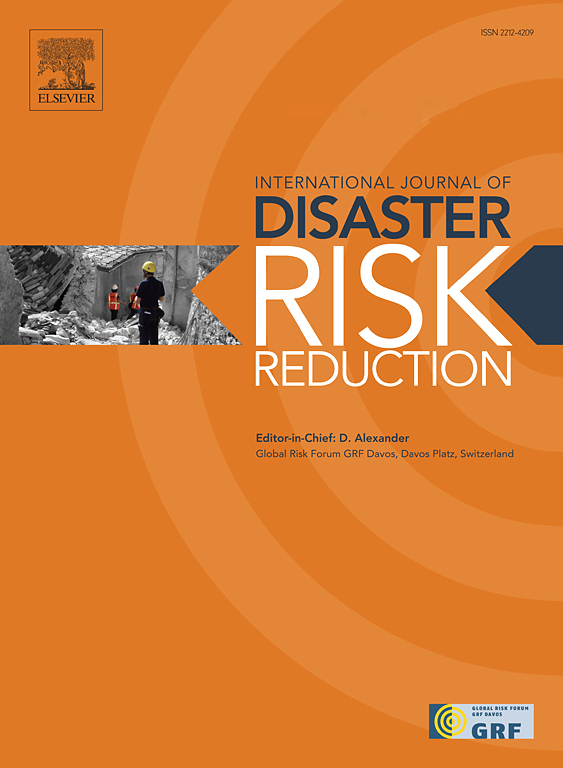A multi-hazard and multi-risk assessment methodological approach to support Civil Protection planning in wide areas
IF 4.2
1区 地球科学
Q1 GEOSCIENCES, MULTIDISCIPLINARY
International journal of disaster risk reduction
Pub Date : 2025-03-01
DOI:10.1016/j.ijdrr.2025.105343
引用次数: 0
Abstract
The paper presents a study having as objective the development of an operational methodology to perform a multi-hazard and multi-risk assessment, including cascading hazards, to support Civil Protection planning in wide areas in Lombardia region. Natural hazards are mainly considered. A semi-quantitative, deterministic approach is adopted in a complete procedure, despite the awareness of current methodological and data barriers. The procedure is implemented in a GIS project, providing a flexible tool. Data are elaborated and represented in minimum cartographic units defined as hexagonal cells. Multi-hazard levels measure the number of spatial overlays and interactions among possible hazards in each cell. Due to lack of data and applicable methodologies, the value of vulnerability to multiple and to multi-hazard, is fixed as a conventional constant equal to 1. Exposure levels measure the presences in each cell of different elements: population, built environment, mobility systems, strategic and relevant facilities for Civil Protection purposes. The combination of multi-hazard and exposure levels, through a specifically designed matrix, gives as result the multi-risk levels (high, medium, low) in each cell. The methodology has been applied in different areas of Lombardia region and the case study of the Brembana valley is presented in this paper. Being a novel approach, this study sets the basis for further developments, enabling, due to its structure, enhancements through integrations and refinements in each phase.
本文介绍了一项研究,其目标是制定一种操作方法,以进行多种灾害和多种风险评估,包括级联灾害评估,从而为伦巴第大区广泛地区的民防规划提供支持。主要考虑的是自然灾害。尽管意识到目前在方法和数据方面存在的障碍,但仍在一个完整的程序中采用了半定量、确定性的方法。该程序在地理信息系统项目中实施,提供了一个灵活的工具。数据以最小制图单位(定义为六边形单元)进行阐述和表示。多重危害等级衡量每个单元中可能存在的危害之间的空间重叠和相互作用的数量。由于缺乏数据和适用的方法,对多重和多种危害的脆弱性值被固定为等于 1 的常规常数。暴露等级衡量每个单元中不同要素的存在情况:人口、建筑环境、移动系统、战略和民防相关设施。通过一个专门设计的矩阵,将多重危险和暴露等级结合起来,得出每个单元的多重风险等级(高、中、低)。该方法已应用于伦巴第大区的不同地区,本文将介绍布雷姆巴纳山谷的案例研究。作为一种新颖的方法,本研究为进一步的发展奠定了基础,由于其结构,每个阶段都可以通过整合和完善进行改进。
本文章由计算机程序翻译,如有差异,请以英文原文为准。
求助全文
约1分钟内获得全文
求助全文
来源期刊

International journal of disaster risk reduction
GEOSCIENCES, MULTIDISCIPLINARYMETEOROLOGY-METEOROLOGY & ATMOSPHERIC SCIENCES
CiteScore
8.70
自引率
18.00%
发文量
688
审稿时长
79 days
期刊介绍:
The International Journal of Disaster Risk Reduction (IJDRR) is the journal for researchers, policymakers and practitioners across diverse disciplines: earth sciences and their implications; environmental sciences; engineering; urban studies; geography; and the social sciences. IJDRR publishes fundamental and applied research, critical reviews, policy papers and case studies with a particular focus on multi-disciplinary research that aims to reduce the impact of natural, technological, social and intentional disasters. IJDRR stimulates exchange of ideas and knowledge transfer on disaster research, mitigation, adaptation, prevention and risk reduction at all geographical scales: local, national and international.
Key topics:-
-multifaceted disaster and cascading disasters
-the development of disaster risk reduction strategies and techniques
-discussion and development of effective warning and educational systems for risk management at all levels
-disasters associated with climate change
-vulnerability analysis and vulnerability trends
-emerging risks
-resilience against disasters.
The journal particularly encourages papers that approach risk from a multi-disciplinary perspective.
 求助内容:
求助内容: 应助结果提醒方式:
应助结果提醒方式:


